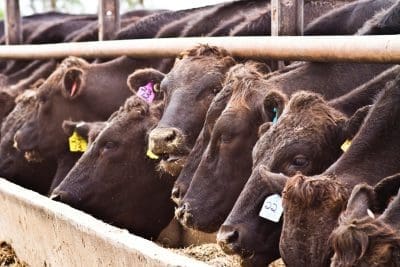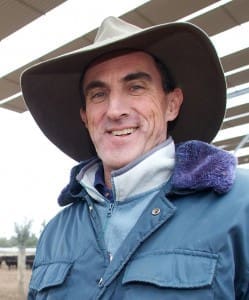CUSTOM-feeding used to play a very large part in the Australian grainfed beef industry.
In times past, the Australian Lot Feeders Association even produced comprehensive custom-feeding ‘directories’ to help beef producers (and other owners of feeder-type cattle) find yards offering contract feeding services.
But it’s evident that there has been a very significant decline in this part of the industry over the past few years.
Here’s a quick list of some large commercial yards that come to mind that have greatly reduced, or moved out of custom feeding altogether, for a variety of reasons:
- Mort & Co Grassdale, Dalby QLD (50,000 head capacity)
- Myola feedlot, Moree, NSW (20,000 head capacity)
- Opal Creek, Milmerran (15,000 head)
- Killara feedlot, Quirindi NSW (20,000 head)
 Even yards like 15,000 head Sandalwood, near Dalby, once dedicated to feeding customers’ (mostly cattle producers) cattle on one-off placement contracts, are now much more heavily aligned with feeding regular ‘program’ cattle owned by processors or supply chains, rather than producers.
Even yards like 15,000 head Sandalwood, near Dalby, once dedicated to feeding customers’ (mostly cattle producers) cattle on one-off placement contracts, are now much more heavily aligned with feeding regular ‘program’ cattle owned by processors or supply chains, rather than producers.
“What’s happened is those custom-fed cattle still go on feed – but they are owned by fewer parties, and tend to be controlled by end-users, rather than the producers at the start of the chain,” an experienced grainfed supply chain manager said.
“There’s definitely a lot less cattle now in Australian feedlots where ‘Ma and Pa’ breeders have retained ownership, and try to sell them at the end of the feeding period,” he said.
Capital was one reason, but also the sheer volatility of profitability in grainfed cattle has also had an impact on custom-feeding, Beef Central was told.
“You put a steer worth perhaps $1380 in feed and fork-out another $480 on feed, and a lot of cattle producer families just don’t have the capital base to do that, on any scale,” the supply chain manager said.
For anybody putting cattle on feed for 100-day programs in the past month, they would want 560c/kg to ‘get out’ of them, for March delivery next year, he suggested. That’s a long way from recent forward pricing of grainfed slaughter cattle for March, at around 520-525c/kg. It’s likely that few people, with the exception of a few who might have bought a few cheap cattle, that have placed ‘non-committed’ cattle under circumstances where there was a 40c/kg gap, worth around $140, on a typical 356kg grainfed carcase.
One processor told Beef Central it had contracted nil grainfed cattle for February next year, when normally by this time his company would have had 5000-6000 grainfed in the books for that period.
Partly offsetting the trend identified above is a population of smaller, less well-known 4000-5000 head yards that have ‘popped-up’ in the custom feeding space. Yards like the Silvano and Cameron family’s yards at Roma were offered as examples of yards that have recently expanded their custom-feeding work.
 Former Australian Lot Feeders Association president Jim Cudmore said the big ‘shake-out’ the industry had had – firstly in 2008-09, and more recently in 2011-12 – had facilitated some lotfeeders and their customers to change their business models.
Former Australian Lot Feeders Association president Jim Cudmore said the big ‘shake-out’ the industry had had – firstly in 2008-09, and more recently in 2011-12 – had facilitated some lotfeeders and their customers to change their business models.
“In the wet 2011-12 years, there was that much grass about that nobody (cattle owners) wanted to custom-feed cattle,” Mr Cudmore said.
“That meant some lotfeeders previously reliant on custom feeding to fill their pens had to find some other way to keep their doors open. What happened at the same time through that period, and the couple of dry spells since, including 2017, processors decided they could not afford to just have feedlots on a ‘wing and a prayer,’ but become more committed to the process,” he said.
Many of those feedlots that were previously heavily underpinned by custom feeding for other clients, were now much more closely involved with ‘program’ business with regular downstream clients.
Opal Creek is one example. Under the management of previous owners/developers, the Lane family, Opal Creek was a dedicated custom-feeding yard. Since purchase by Australian Country Choice, however, that has stopped, replaced entirely by company-owned cattle.
“Yards that previously offered custom-feeding services to virtually anybody with cattle who picked up the phone, have had to more closely align themselves with supply chains – to give themselves some continuity of supply,” Mr Cudmore said.
“The only profitable feedlot is a full feedlot, and the problem with traditional custom-feeding was that it was very cyclical, dependent in the seasons,” he said. “Yards worth millions of dollars could not afford to be sitting around idle during the wet years 2011-12, at 30 or 40 percent occupancy.”
Grainfed processors like Teys, Kilcoy, Nolans and further south, Thomas Foods International, had done the same thing, in building this ‘program’ business, rather than relying too much on the custom-fed spot market, Mr Cudmore said.
Expansion in Wagyu feeding had probably also contributed to the recent trend.
“There’s clearly more retained ownership either by the brand owner, or the cattle producer. There’s still a reasonable amount of custom feeding going on, specifically in the Wagyu space,” he said.
Mr Cudmore said there was always likely to be ‘some element’ of traditional custom-feeding for producer cattle owners in the industry, but it was unlikely ever to return to the levels seen in years gone by, in his opinion.
“Processors have had to become more committed to the whole process. Processors themselves own the cattle in some of these feedlots to day – which technically is still ‘custom-feeding’, but just not the traditional form of custom feeding where the person who bred the animal owned him right through the lotfeeding process,” he said.
“That has probably served to ‘de-risk’ processors’ business, but probably also increased their exposure to cattle.”

All very interesting stuff! To my knowledge – there are only 2 Works in the whole country -WHERE a producer can retain meat ownership! ie Custom kill.
The fact is that cattle supplies are short(production cattle) and all these alliances that own a meatworks- are in effect saying”sod off” with your client kills – we want 100% of the cream!. So UNLESS you are a multinational feedlotter(or joined @ the hip)- build a works or start begging -just like the livestocker producers -have to!